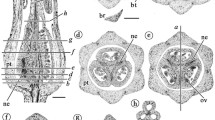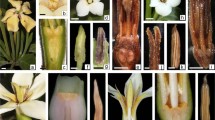Abstract
An analysis of the morphology, anatomy and ontogeny of the flowers, particularly of the gynoecium ofLagoecieae is presented. 1. The gynoecial model of angiosperms can be applied to all three generaArctopus, Lagoecia andPetagnia. 2. In the case ofArctopus an additional “Apikalseptum” is developed. 3. In the synascidiate region of the gynoecium the adaxial carpel is reduced inArctopus andPetagnia, the abaxial inLagoecia. 4. The reduced carpel produces either one mature ovule inArctopus, a rudimentary ovule inPetagnia, or none inLagoecia. 5.Petagnia andLagoecia have a completely pseudomonomerous gynoecium. 6.Arctopus displays many flower characteristics which lack in theSaniculoideae but occur in theHydrocotyloideae. 7. ForPetagnia andLagoecia an independent phylogenetic development within theSaniculoideae is assumed.
Similar content being viewed by others
Literatur
Baillon, H., 1879: Histoire des plantes7. — Paris: Hachette & Cie.
Brullo, S., Grillo, M., Guglielmo, A., 1976: Osservazioni ecologiche preliminari suPetagnia saniculifolia Guss., raro endemismo sicula. — Giorn. Bot. Ital.110, 293–296.
Drude, O., 1898:Umbelliferae. InEngler-Prantl: Die Natürlichen PflanzenfamilienIII/8. — Leipzig: W. Engelmann.
Eckardt, T., 1937: Untersuchungen über Morphologie, Entwicklungsgeschichte und systematische Bedeutung des pseudomonomeren Gynoeceums. — Nova Acta Leop. N. F.5, 1–112.
Eichler, W., 1878: Blüthendiagramme2. — Leipzig.
Froebe, H. A., 1964: Die Blütenstände der Saniculoideen (Umbelliferae). — Beitr. Biol. Pfl.40, 325–388.
—, 1979: Die Infloreszenzen der Hydrocotyloideen (Apiaceae). — Trop. u. Subtrop. Pflanzenwelt29, 462–658.
—, 1978: Pseudanthien bei Umbelliferen. — Beitr. Biol. Pfl.54, 175–206.
Hartl, D., 1956: Morphologische Studien am Pistill der Scrophulariaceen. — Österr. Bot. Z.103, 185–242.
—, 1962: Die morphologische Natur und die Verbreitung des Apicalseptums. — Beitr. Biol. Pfl.37, 241–330.
Leinfellner, W., 1941: Über den unterständigen Fruchtknoten und einige Bemerkungen über den Bauplan des verwachsenblättrigen Gynözeums an sich. — Bot. Arch.42, 1–43.
—, 1950: Der Bauplan des synkarpen Gynözeums. — Österr. Bot. Z.97, 404–436.
Magin, N., 1977: Das Gynoeceum derApiaceae — Modell und Ontogenie. — Ber. Deutsch. Bot. Ges.90, 53–56.
- 1978: Blütenmorphologische Untersuchungen anActinotus Lab. unter besonderer Berücksichtigung des Gynoeceums. — InCauwet-Marc, A. M., Carbonnier, J., (Ed.): Actes du 2ème Symp. internat. sur les Ombellifères, Contribut. pluridiscipl. à la Systématique, 749–764. — Perpignan.
- Vergleichend morphologische und anatomische Untersuchungen am Gynoeceum der Apiaceen (in Vorbereitung).
Troll, W., 1928: Zur Auffassung des parakarpen Gynoeceums und des coenokarpen Gynoeceums überhaupt. — Planta6, 255–276.
—, 1939: Die morphologische Natur der Karpelle. — Chron. Bot.5, 38–41.
Wolff, H.:Umbelliferae-Saniculoideae. InEngler, A., (Ed.): Das Pflanzenreich4, H. 61, 1913.
Author information
Authors and Affiliations
Additional information
Herrn Univ.-Prof. Dr.Walter Leinfellner zum 70. Geburtstag gewidmet.
Rights and permissions
About this article
Cite this article
Magin, N. Eine blütenmorphologische Analyse derLagoecieae (Apiaceae). Pl Syst Evol 133, 239–259 (1980). https://doi.org/10.1007/BF00984382
Received:
Issue Date:
DOI: https://doi.org/10.1007/BF00984382




